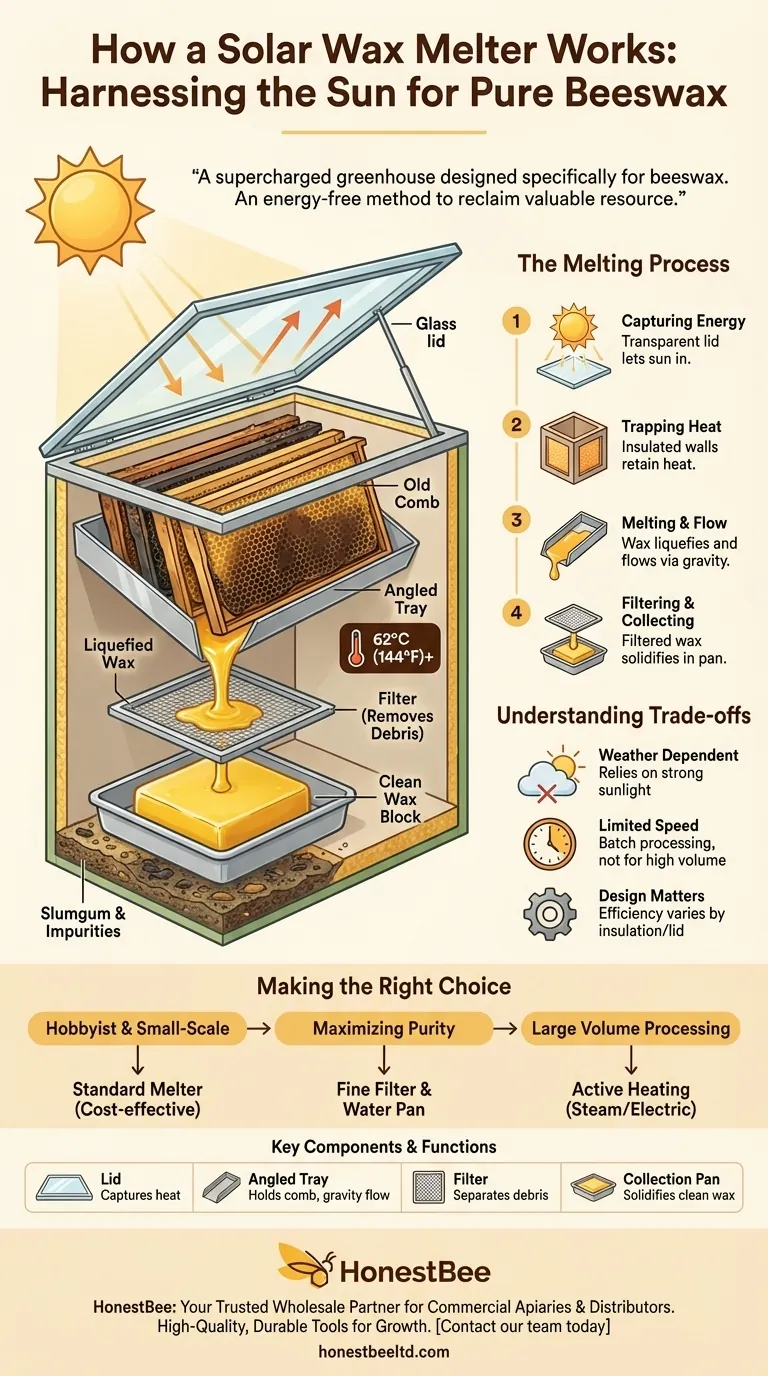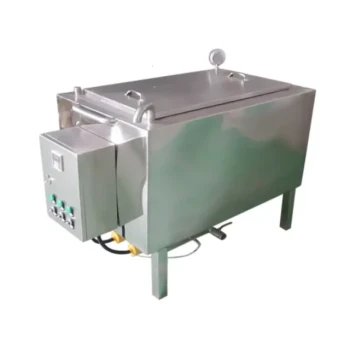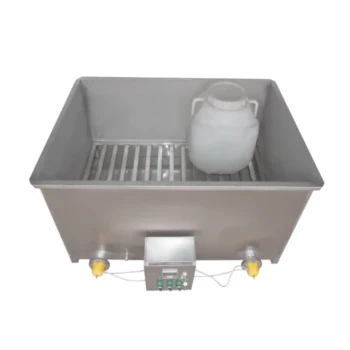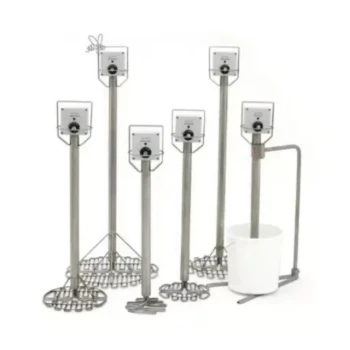At its core, a solar wax melter functions like a supercharged greenhouse designed specifically for beeswax. It is a simple, passive device that uses the sun's trapped heat to melt wax from old honeycombs. The liquid wax is then naturally filtered by gravity, separating it from debris and collecting it in a pan for reuse.
A solar wax melter leverages the greenhouse effect to separate pure beeswax from old comb and frames. It provides an energy-free and environmentally friendly method for beekeepers to reclaim a valuable resource with minimal effort.

The Fundamental Principle: Harnessing Solar Power
A solar wax melter's effectiveness comes from its ability to efficiently capture and retain the sun's energy to reach the melting point of beeswax.
Capturing Solar Energy
The top of the melter is a transparent lid, typically made of glass or a durable plastic. This lid allows the sun's shortwave radiation to pass through and enter the box.
Trapping Heat
Once inside, the solar energy is absorbed by the dark combs and the interior surfaces of the box, re-radiating as heat. The insulated walls and the glass lid prevent this heat from escaping, causing the internal temperature to rise significantly, often reaching over 62°C (144°F), the melting point of beeswax.
A Walkthrough of the Melting Process
The internal design of the melter is engineered to use gravity to separate the pure wax from the leftover debris, often called "slumgum."
Loading the Comb
Old frames or loose pieces of honeycomb are placed inside the melter. They typically rest on a metal tray or mesh screen that is fixed at an angle.
Melting and Separation
As the internal temperature rises, the wax liquefies. Due to the angled design of the holding tray, the liquid wax begins to flow downward, leaving the heavier, solid impurities behind.
Filtering Out Debris
The melted wax must pass through a filter or screen before reaching the collection area. This grid catches the slumgum—old cocoons, propolis, and other hive debris—ensuring only clean wax proceeds.
Collecting the Pure Wax
The filtered, liquid wax finally drips into a collection pan or mould at the lowest point inside the melter. Some designs have the wax drip into a pan of water, which can help clean it further. Once cooled, the wax solidifies into a clean, usable block.
Understanding the Trade-offs
While highly effective, the solar wax melter has operational limitations that are important to understand.
Complete Dependence on Weather
The device is entirely reliant on strong, direct sunlight. It will not function effectively on cloudy, overcast, or cool days. Performance is directly tied to the weather and the season.
Limited Processing Speed
A solar melter is a batch-processing tool. It is ideal for hobbyists or small-scale beekeepers but is not designed for processing large quantities of comb quickly, as a commercial operation might require.
Efficiency Varies by Design
The effectiveness of a melter depends heavily on its construction. Models with thickly insulated walls and double-paned glass lids are far more efficient at reaching and maintaining high temperatures than simpler, uninsulated designs.
Making the Right Choice for Your Goal
Selecting or building a solar wax melter depends entirely on the scale of your beekeeping operation and your primary objective.
- If your primary focus is hobby beekeeping: A standard commercial or well-built homemade solar melter is an extremely cost-effective and valuable tool for reclaiming wax.
- If your primary focus is maximizing wax purity: Look for designs with a fine mesh filter or a collection pan that utilizes water, which helps the wax form a clean, separated cake on top.
- If your primary focus is processing large volumes quickly: A solar melter is insufficient for this purpose; you should explore active heating methods like steam or electric wax melters.
By understanding these simple principles, you can effectively reclaim valuable beeswax using nothing more than the power of the sun.
Summary Table:
| Key Component | Function | Ideal For |
|---|---|---|
| Transparent Lid | Captures and traps solar energy as heat. | Hobbyist & Small-Scale Beekeepers |
| Angled Metal Tray | Holds comb, allowing melted wax to flow via gravity. | Maximizing Wax Purity |
| Internal Filter | Separates pure wax from debris (slumgum). | Energy-Free, Eco-Friendly Processing |
| Collection Pan | Collects the filtered, liquid wax to solidify. | Batch Processing of Old Comb |
Ready to upgrade your beekeeping operation with reliable, high-quality equipment?
As HONESTBEE, we are your trusted wholesale partner, supplying commercial apiaries and equipment distributors with the durable, efficient tools they need to succeed. Whether you're looking to expand your wax processing capabilities or source premium beekeeping supplies, our wholesale-focused operations are designed to support your growth and profitability.
Contact our team today to discuss your specific needs and discover how our products can enhance your efficiency and bottom line.
Visual Guide

Related Products
- Solar Beeswax Melter Easy Solar Wax Melter for Beeswax
- Electric Commercial Beeswax Melter for Factory Use
- Steam Beeswax Melter Wax Warmer for Wax Processing
- Beeswax Melter for Candle Making Honey Bee Wax Melter
- Electric Honey Press Machine for Squeezing Honey Comb Press Equipment
People Also Ask
- How long does it take for the Solar Wax Melter to warm up? Get Melting in 30 Minutes
- What are the main advantages of the solar waxing machine? Harness the Sun for Pure, Cost-Free Beeswax
- What should be done with scraps after cutting foundation? Save, Wash, and Re-Melt for Sustainability
- What are the potential uses of the molten beeswax produced by a Solar Wax Melter? Turn Waste into Value
- How does the solar wax extraction method work? Reclaim Pure Beeswax with Sun Power



















